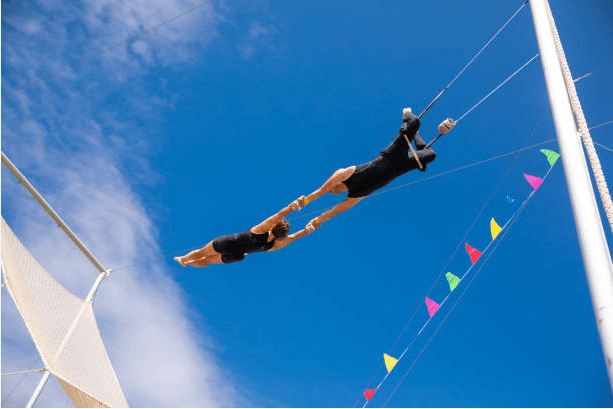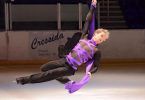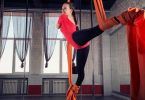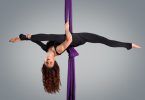Circus performance demands a high level of physical strength, flexibility, and skill, making circus injury prevention essential for every performer. Without proper precautions, repetitive movements and high-impact acts can lead to injuries that may disrupt your career. This article will focus on essential circus injury prevention strategies, helping performers avoid common issues and stay healthy.
1. Prioritize a Comprehensive Warm-Up
1. Warming Up: A Crucial Step in Circus Injury Prevention
Warming up is crucial for preparing your body for the physical stresses of circus performance. A good warm-up increases blood flow to your muscles, enhances flexibility, and reduces the risk of strains and sprains. Start with light aerobic activities such as jogging or jumping jacks to increase your heart rate. Follow this with dynamic stretches that mimic the movements of your routine to prepare further your muscles and joints (American College of Sports Medicine).
2. Targeted Warm-Up Exercises for Injury-Free Circus Performances
Tailor your warm-up to the specific demands of your performance. For example, if your act involves aerial silks, include exercises that target your grip strength and upper body flexibility. If performing acrobatics, focus on warming up your legs and core. This targeted approach ensures that you’re adequately prepared for the unique challenges of your act.

2. Building Strength and Flexibility to Prevent Circus Injuries
1. Core Strength: The Foundation of Circus Safety and Injury Prevention
A strong core is essential for maintaining balance and stability during complex circus routines. Incorporate exercises such as planks, Russian twists, and leg raises into your training regimen to build core strength. A strong core helps prevent injuries by supporting your spine and improving overall body control.
2. Improving Flexibility to Reduce Circus Injury Risk
Flexibility is vital for many circus acts, from contortion to aerial performances. Regular stretching and flexibility exercises help maintain and improve your range of motion. Incorporate static stretching into your daily routine and consider practices like yoga to enhance overall flexibility and reduce muscle tightness.
3. Practice Proper Technique
1. Perfect Your Technique to Avoid Circus Injuries
Executing movements with the correct technique is crucial for injury prevention. Work closely with a coach or trainer to ensure you’re performing each move with proper form. Incorrect technique can lead to unnecessary strain on your muscles and joints, increasing the risk of injuries. Regularly review and refine your techniques to ensure optimal performance and safety.
2. Use Proper Equipment
One of the key factors in preventing injuries is using the right equipment. High-quality aerial gear, such as silks, hoops, or trapeze, can make a significant difference in both performance and safety. When you’re working with equipment that’s durable and reliable, you reduce the risk of unexpected malfunctions. At Vertical Wise Shop, we offer a range of professional-grade aerial equipment designed to support your performance and keep you safe, so you can focus on perfecting your craft.
4. Listen to Your Body
1. Overuse and Circus Injury: Know the Warning Signs
Pay close attention to your body’s signals. Persistent aches, pains, or discomfort can be signs of overuse or impending injury. If you notice these symptoms, it’s important to take a break and allow your body time to rest and recover. Ignoring these signs can lead to more serious injuries and longer recovery times.
2. Seek Medical Attention
If you do experience an injury or ongoing pain, seek medical advice promptly. A healthcare professional can provide a proper diagnosis and recommend a treatment plan. Early intervention can prevent further damage and facilitate a quicker recovery.
5. Implement Effective Recovery Practices
1. Recovery Routines to Prevent Circus-Related Injuries
Develop a recovery routine that includes rest, proper nutrition, and hydration. Rest is essential for muscle repair and overall recovery. Incorporate rest days into your training schedule and consider activities such as massage therapy or foam rolling to aid in muscle recovery.

2. Focus on Nutrition and Hydration
Proper nutrition and hydration are crucial for maintaining your physical health and preventing injuries. Eat a balanced diet rich in vitamins and minerals to support muscle function and overall well-being. Stay hydrated by drinking plenty of water throughout the day to keep your muscles functioning optimally.
6. Employ Preventative Measures
1. Essential Equipment for Circus Injury Prevention
Consider using protective gear such as wrist guards, knee pads, or ankle supports during training and performances. Protective gear can help absorb impact and reduce the risk of injuries from falls or collisions.
2. Maintain a Balanced Training Routine
Avoid overtraining by balancing high-intensity workouts with adequate rest and recovery periods. A well-rounded training routine should include strength, flexibility, and conditioning exercises. Overtraining can lead to fatigue and increase the likelihood of injuries.
Conclusion: Staying Safe and Healthy in the Circus Arts
In the world of circus arts, taking care of your body is just as important as honing your craft. By prioritizing circus injury prevention—from warming up and using proper techniques to incorporating strength training and recovery routines—you can minimize the risk of injury and maintain your physical health. Remember, safety comes first, and these injury prevention strategies will help ensure a long and thriving career in the circus arts.
What are your top tips for preventing injuries as a circus performer? Have you experienced any challenges in maintaining your health? Share your experiences and advice in the comments below—your insights could be valuable to fellow circus artists striving for safety and success!










